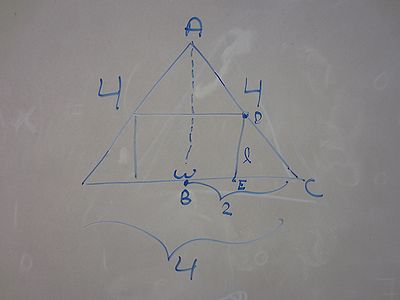Science:Math Exam Resources/Courses/MATH110/April 2013/Question 05
{{#incat:MER QGQ flag|{{#incat:MER QGH flag|{{#incat:MER QGS flag|}}}}}}
• Q1 (a) • Q1 (b) • Q1 (c) • Q1 (d) • Q2 (a) • Q2 (b) • Q2 (c) • Q2 (d) • Q3 (a) • Q3 (b) • Q3 (c) • Q3 (d) • Q3 (e) • Q4 • Q5 • Q6 • Q7 • Q8 • Q9 (a) • Q9 (b) •
Question 05 |
|---|
|
Consider an equilateral triangle whose sides are of length 4. Determine the dimensions of the largest rectangle which may be inscribed inside the triangle if one side of the rectangle lies on the base of the triangle. |
|
Make sure you understand the problem fully: What is the question asking you to do? Are there specific conditions or constraints that you should take note of? How will you know if your answer is correct from your work only? Can you rephrase the question in your own words in a way that makes sense to you? |
|
If you are stuck, check the hints below. Read the first one and consider it for a while. Does it give you a new idea on how to approach the problem? If so, try it! If after a while you are still stuck, go for the next hint. |
Hint 1 |
|---|
|
Try drawing a picture of the rectangle and triangle. Is there a way to relate the height and width of the rectangle using a property of triangles? |
Hint 2 |
|---|
|
To relate the height and width of the rectangle using an equation, use similar triangles. You'll need to calculate the height of the triangle using either the Pythagorean theorem or special triangles. |
Hint 3 |
|---|
|
Once the height and width of the rectangle are related in an equation, solve for either variable and plug the resulting expression into the formula for the area of the rectangle. This new area formula is what you want to maximize. |
|
Checking a solution serves two purposes: helping you if, after having used all the hints, you still are stuck on the problem; or if you have solved the problem and would like to check your work.
|
Solution |
|---|
|
Let's start with drawing a sketch. The area of the rectangle with width w and length l is given by
The constrains are 0 ≤ w ≤ 4, 0 ≤ l ≤ h, where h is the height of the surrounding triangle. However, w and l are not independent: a larger width results in a shorter length and vice versa. Hence, the next step is to express the formula for the Area with respect to just one variable. We achieve this by observing the similar triangles ABC and DEC to find or, equivalently, Plugging this into the formula for the Area of the rectangle we find Now, that we expressed the Area as a function of just one variable, we can go about maximizing it as usual: Set the derivative to zero and solve for the variable l: Setting this expression to zero we obtain l = h/2 as critical point. Since the area vanishes at the endpoints, Area(0) = 0 and Area(h) = 0, the critical point l = h/2 is the maximum we are looking for. Hence, the dimensions of the rectangle that maximizes the area are |
{{#incat:MER CT flag||
}}






